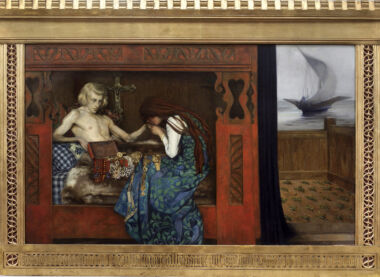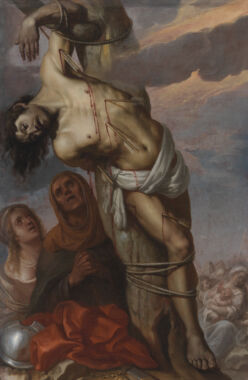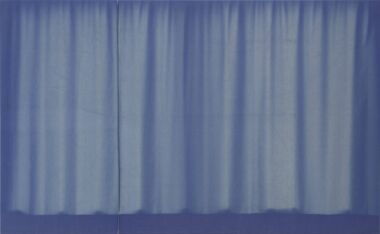Summary
The article places Rosa’s two paintings of philosophers within a historical context, demonstrating how their subject matter and formal devices bring together and expose a range of important themes in seventeenth-century art theory. The question of the sublime is linked to the connection between the aesthetic and the ethical in the artist and the work of art, to the melancholic temperament and to the concept of genius as it appeared within the art theoretical context of the day. The article shows that the two philosopher-paintings may have been included amongst what Salvator Rosa himself regarded as sublime motifs. They can be interpreted as a public launch and presentation of the artist’s new perception of the artist self, which incorporated multiple identities: Stoic philosopher, poet, satirist and painter of ethical-moral (sublime) inventions.
Articles
Ma nell’ antichità non vo’ ingolfarmi.
Mira, come danno aura al Buonarruoti
Non men le carte, che le tele, e I marmi.
Se i libri del Vasari osservi e noti,
Vedrai che de’ pittori i più discreti
Son per la poesia celebri e noti.
E non solo I pittori eran poeti,
Ma filosofi grandi, e fur demoni
Nel cercar di Natura I gran segreti.
(from Salvator Rosa’s satire L’Invidia)1
Prologue
One of Erik Zahle’s feats as curator at the National Gallery of Denmark was the acquisition, in 1936, of Salvator Rosa’s monumental pendants depicting ancient philosophers.2 Salvator Rosa (1615–73) was in his mid-thirties when he set out to paint Democritus in Meditation (1650–51) and Diogenes casting away his bowl (1651–52). [figs. 1-2] The decision to paint not just one, but two paintings on this vast scale should be seen in light of the fact that at this point Salvator Rosa had just returned to Rome after a decade of working in Florence. The two paintings, hereinafter also known as the pendants, were intended to call attention to his ability as a history painter, attracting clients to his newly established business. As a young artist Salvator Rosa specialised in battle scenes and landscapes inspired by the wild countryside around Naples, but he wished to be known as a history painter.3
I shall read and interpret the pendants in the light of a range of seventeenth-century art theoretical concepts and their interrelationships. This will include the concepts of virtú (virtue), the melancholic temperament, and genius as seen in relation to the sublime. The Baroque era’s understanding of the sublime is characterised by its ethical dimension, for the meaning of that concept has shifted and changed over time.4 In antiquity and in the Baroque era the sublime was framed by the discipline of rhetoric. Scholars and artists would read Longinus’s treatise on the sublime, Perì Hýpsous, (On the Sublime), which was edited as a printed book for the first time in 1554 in Greek, 1566 in Latin and in 1639 in Italian.5 From the time of the arrival of Nicolas Despréaux-Boileau’s 1674 French translation of Longinus (Traité du Sublime), the concept became associated with a particular aesthetic that could be learned and appropriated. During the eighteenth century and the first decades of the nineteenth century, the sublime was exclusively associated with aesthetics, but in Longinus and in the Baroque readings of Longinus it also encompassed a strong ethical-cum-moral element that was associated partly with the subject (the orator, poet or artist), but also with the work and its impact on the audience.
This article addresses the possibility that Salvator Rosa might also have had philosophers in mind when he spoke of ‘sublime subjects’: it reviews the literary sources that Salvator Rosa may have known, and which may have shaped his perception of the two philosophers’ lives and thinking. The focus then shifts to the ethical and moral aspects of Longinus’s treatise, which offers a direct connection between the sublime and the ethics and lifestyles of pre-Socratic philosophers. The article also picks up on connections to the conceptual framework established by Giorgio Vasari (1511–74) concerning the status of the artist, the theme of the sublime and the perception of genius.6 The objective of the article is also to show how a range of formal devices such as oscuritá and amplificatio and can be linked directly to Longinus’s concept of the sublime and to Vasari.
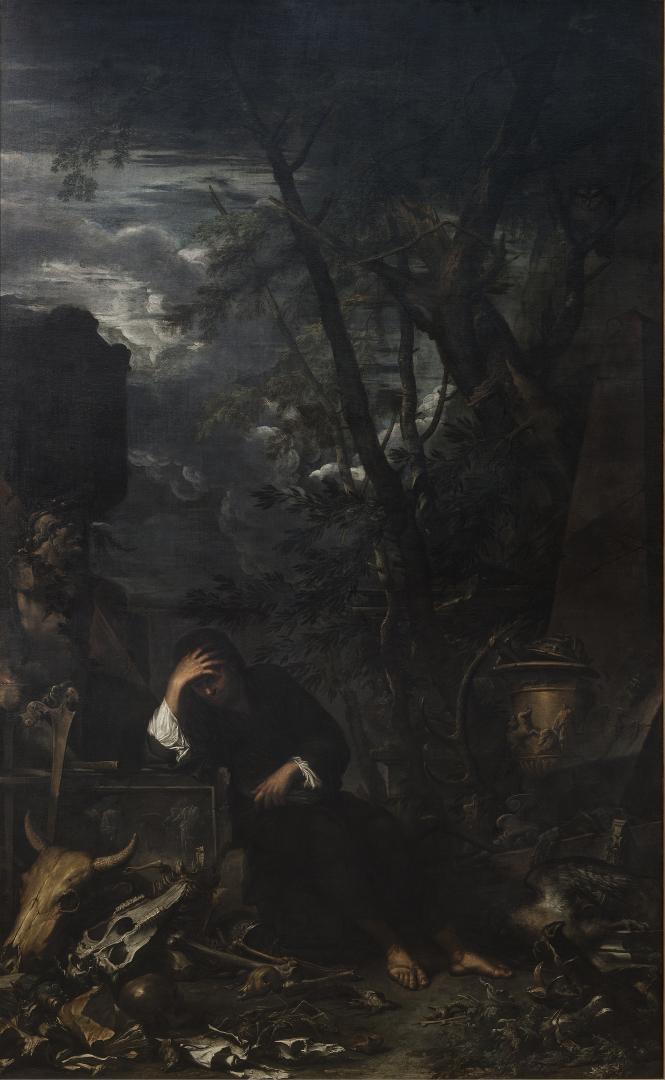
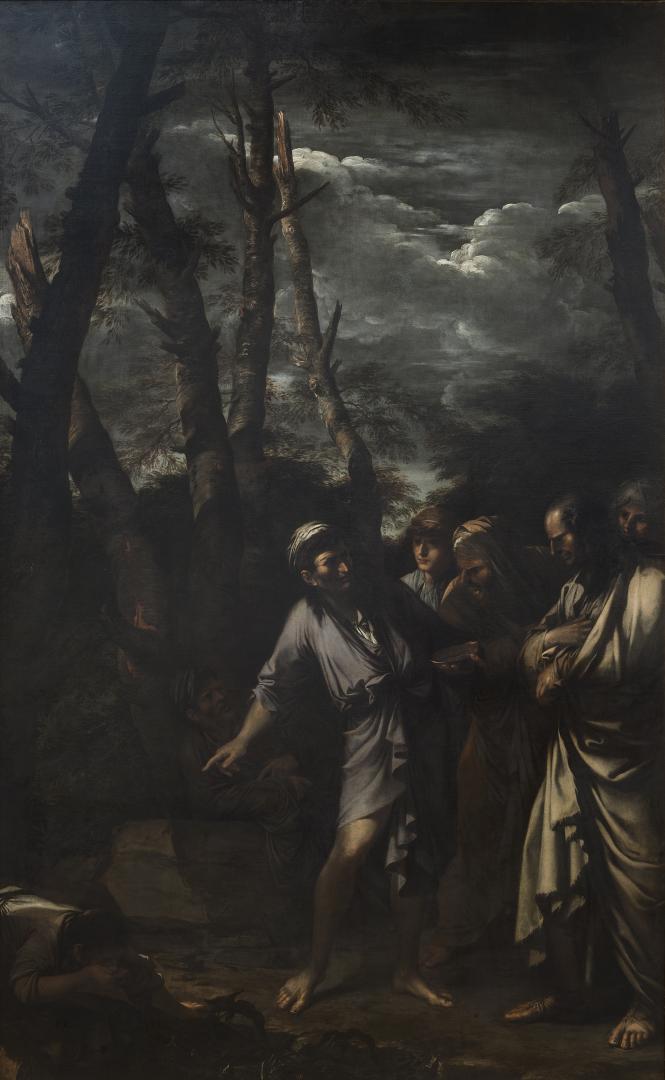
The mute language of painting
The pendants show the two philosophers in the same forest, disregarding the fact that they did not live at the same time. They also occupy the same dusky setting where the cold white light of the moon seems to be the only source of light. Clouds drift by in the sky above, and an owl, bird of night, sits silently on a branch high above Democritus. While Diogenes is surrounded by an audience, Democritus is alone. He has just shut the pages of a large book, cradling it in his lap. Wearing an expression of wry mournfulness, he gazes inwards – his head cradled in his hand as he leans up against a sarcophagus. Among the teeming wealth of detail in this composition, Salvator Rosa has taken pains to depict a number of familiar, yet enigmatic relics from the monument culture typical of antiquity. The sheer variety of types on display makes it seem as if Salvator Rosa is eager to demonstrate the scope of his knowledge and education: here we find a tripod, an urn, a sarcophagus, a stele, and to the left is a herm in the shape of Terminus, god of transitions. To the right is a toppled stele with mysterious hieroglyphics, identified by Richard W. Wallace as a stele reproduced in Valeriano’s Hieroglyphica, on which the inscription “Humanae Vitae Conditio” (the condition of human life) points to how death is a universal fact.7 Dead animals surround Democritus. Most of the animal carcases have become skeletons, and by the feet of Democritus we also find a human skull between an array of books and documents showing geometric figures. In the background a human skeleton tumbles out from a desecrated grave, the totality offering an eerie reminder of the inevitability of death. [fig. 3]
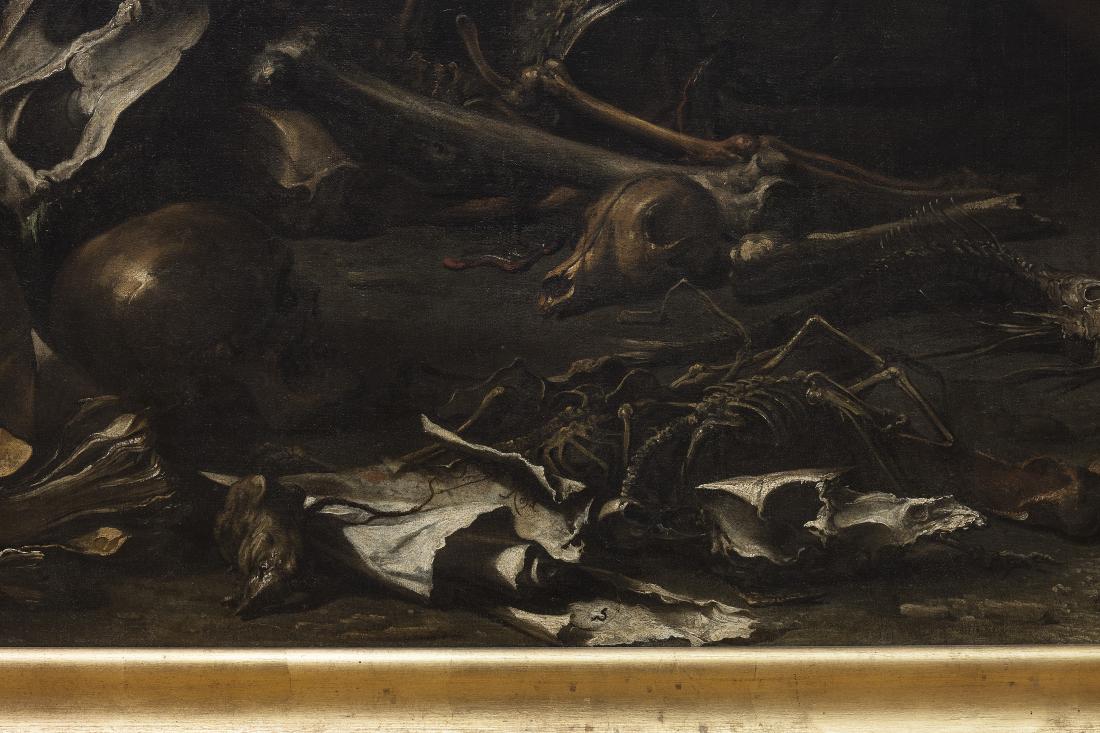
The darkness that envelops Democritus makes it difficult to make out all the details; even the philosopher’s face resides in shadow, apart from the tip of his nose. The same dark manner of painting cloaks the details in the Diogenes painting. Diogenes’s face is cut through by a diagonal shadow; perhaps Salvator Rosa has painted metaphorical shadows here and in the face of Democritus. Several of Diogenes’s followers listen attentively from the gloom, and the boy who serves as the subject of his speech is at the very front of the shadowy foreground. There are countless nuances of black here, ranging from the brown-hued and reddish to green-hued, bluish and violet blacks.
In these pendants Salvator Rosa chose to create a tightly condensed pictorial space where the spectator’s eye is not allowed to roam out into infinity, but is stopped at the first plane. Salvator Rosa has opted for a radical solution in the upright format of these compositions, for the figures take up only the lower half while slender tree trunks and the sky make up the uppermost part. We are in a desolate place where torn and broken trees and branches testify to the raw forces of nature as expressed in inclement weather and horrific storms. Employing an exquisite compositional device, Salvator Rosa uses the tree trunks to echo the philosophers’ poses. The governing idea behind Salvator Rosa’s composition unfurls itself through this device, showing how a repetition, expansion or extension – a ‘principle of amplification’ – intensifies and enhances the overall feel of the painting. It is via such amplificatio that Salvator Rosa achieves an effective sense of harmony and interplay in the composition and a strong visual pull between the philosophers, the tree trunks and the skies in the two works.
Typically of Salvator Rosa, the paintings were not, despite their large scale, commissioned pieces, but his own free inventions. He painted Democritus in Meditation in 1650 while staying in Monte Rufoli with friends of his, the brothers Maffei. In a letter dated 3 October 1650 Salvator Rosa says: “we are still at Monte Rufoli, and we will stay here for another eight days to accommodate a large canvas I have had to complete, and now we must wait for it to dry so that it can be rolled up”.8 The painting was to be transported to Rome, and in March of 1651 it was exhibited in the Pantheon, which was used as a church at the time (Santa Maria dei Martiri). Salvator Rosa used the first public exhibition of the year to present his new masterpiece.9
Salvator Rosa had generated considerable interest in the upcoming reveal of the Democritus painting by being very secretive, barring all except one friend from access to his studio. With all this mystique surrounding the painting, its unveiling was eagerly anticipated. Rosa sought to sell the work, but was unable to fetch the price he wanted.10 A patron bought it for 250 scudi, but the deal was cancelled. Perhaps it was at this point that he decided to create a companion piece for Democritus in the form of Diogenes casting away his bowl. The Venetian envoy in Rome, Niccolò Sagredi, bought the pendants for 300 ducats at some point before 6 July 1652. He later took them to his hometown, where they remained in his family’s ownership for many generations. Salvator Rosa later regretted this sale because the newly appointed papal legate, Monsignore Gaetano, would have paid 500 scudi and given the two philosopher paintings to the Habsburg king Philip IV (king 1621–65), who ruled Spain, Portugal, Naples and Sicily.
Scenes depicting ancient philosophers were popular at the time, and in 1662, long after he created the pendants, Salvator Rosa did a number of prints depicting philosophers and ascetic hermits. His paintings formed the basis for the prints depicting Democritus and Diogenes, whereas the other images – leaves showing scenes such as Diogenes and Alexander, Plato’s Academy, etc. – exist only as prints. [figs. 4-5]11 In Salvator Rosa’s graphic oeuvre the pictures no longer act as pendants. Indeed, pairing up Democritus and Diogenes was not usual within seventeenth-century Italian painting.
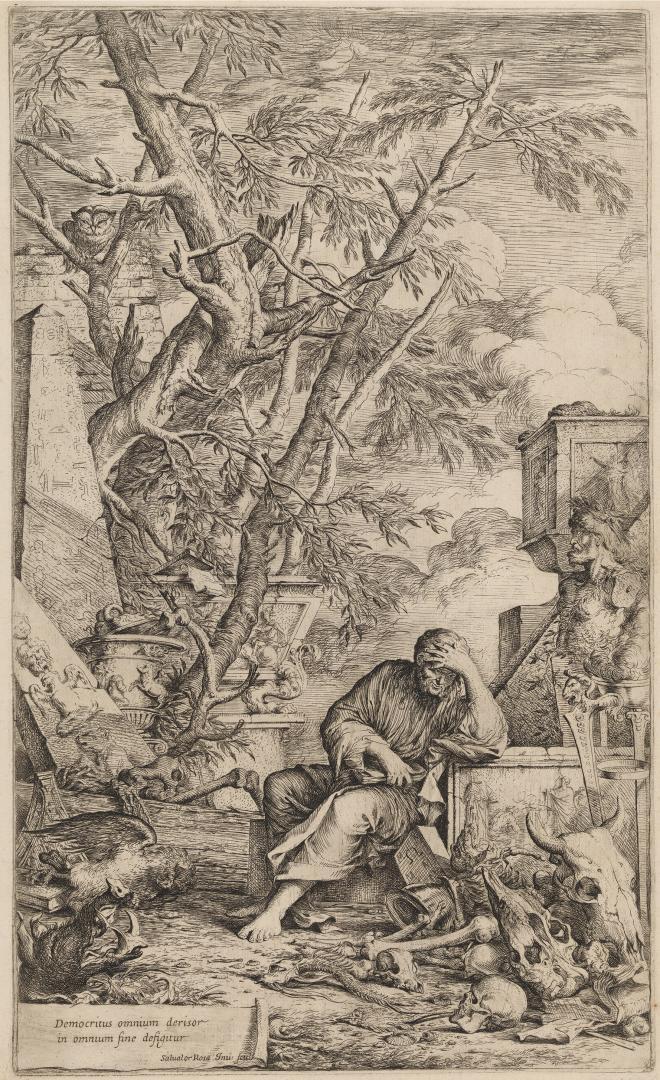
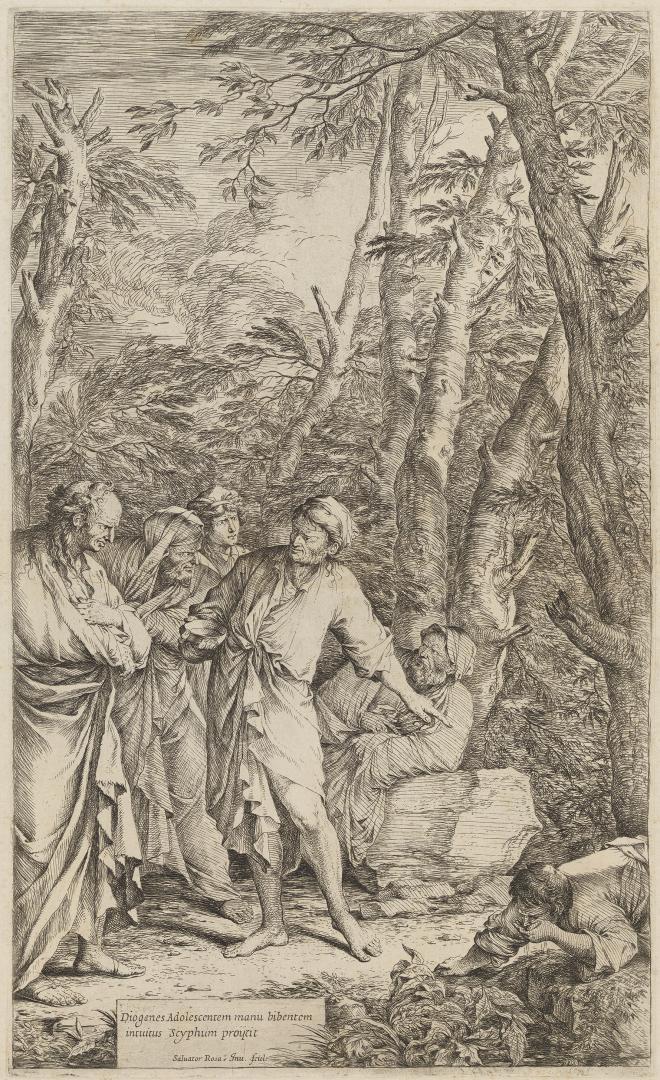
Research history
Democritus in Meditation and Diogenes casting away his bowl have been the subject of much art historical research. Baldinucci described the Democritus painting with particular emphasis on its transitory elements: “Democritus contemplating a large quantity of skeletons and other decayed and devoured things.”12 Erik Zahle identified the literary source of the paintings as an apocryphal letter by Hippocrates, and others have found supplementary sources such as Lucian’s The Lover of Lies, or The Doubter, in which Democritus shuts himself up in a tomb in order to find the peace and quiet necessary to write.13 Wallace (1968) and others have discussed the vanitas iconography, identifying the monuments that surround Democritus.14 In her doctoral dissertation (1978) Wendy Wassyng Roworth offers an explanation of why Salvator Rosa chose to make pendants of Democritus and Diogenes: taking her starting point in Robert Burton’s Anatomy of Melancholy (1621) she inscribes the two philosophers in the familiar dichotomy vita contemplativa – vita activa, with Democritus as the meditating melancholic and Diogenes as the one who translates the thoughts of an ideal life into actual practice.15 In this sense Salvator Rosa addresses, according to Roworth, Aristotle’s separation of philosophy into the contemplative and the active; Aristotle delegated physics and logics to the field of theory, whereas ethics and politics belonged to the practical sphere.16 In an aside, Salvator Rosa may also have been visually inspired by the frontispiece of Burton’s The Anatomy of Melancholy, where one of the small scenes in the margin shows Democritus sitting in his garden in Abdera with a book on his lap and his head resting on his hand.17
Haskell (1980) was the first scholar to account for the public exhibitions’ function as marketing vehicles that allowed artists to showcase and sell work outside the scope of the conventional and powerful patrons and institutions that commissioned work.18 This theme has subsequently been addressed in depth by Xavier F. Salomon in the catalogue for the 2010 exhibition Salvator Rosa (1615–1673) Bandits, Wilderness and Magic at the Dulwich Picture Gallery, London and at the Kimbell Art Museum, Texas.19
In the exhibition catalogue Salvator Rosa. Tra mito e magia (2008) Caterina Volpi sees Democritus and Diogenes as personifications of ‘the new man’, i.e. of the learned humanist who is as interested in studies of zoology as he is in anatomy, alchemy, astrology and Egyptology.20 Volpi takes the Renaissance world view expressed by the Wunderkammer distinction between artificialia and naturalia and applies it to the pendants, linking them to Salvator Rosa’s time in Florence where there was an established circle of clients for philosopher scenes among the city’s intellectual scene – unlike in Rome, where he struggled to sell the monumental pendants at the desired price. In the same exhibition catalogue Ebert-Schifferer contextualizes the Copenhagen Demokritus and Diogenes within Rosa’s memento mori and whichcraft motives in relation to the Wunderkammer of that time.21
In 2010 Volpi, Sybille Ebert-Schifferer and Helen Langdon published the anthology Salvator Rosa e il suo tempo 1615–1673, in which Francesco Lofano writes about the iconography of the Democritus scene, pointing to hitherto unknown written sources (Tasso and Torquato Accetto) and describing the Democritus motif as the era’s emblem and paradigm for the melancholic temperament.22 Caterina Volpi’s monograph Salvator Rosa (1615-1673): ’Pittore famoso’ (2014) with a total of 685 pages and 325 catalogued paintings, is a substantial source to scolarly knowledge on Salvator Rosa.23 Of the Democritus in Copenhagen Volpi provides to the context and reception.
In the exhibition catalogue Salvator Rosa (1615–1673) Bandits, Wilderness and Magic (2010) Helen Langdon focuses on the vanitas theme: “[the paintings] show Democritus bewailing human vanity and corruption, while Diogenes extols the virtues of the simple life ….. Rosa now emphasizes Diogenes the teacher”.24 Langdon does not think that Salvator Rosa identified with these philosophers. Her reading of selected works on the basis of seventeenth-century aesthetic theory is rich in perspectives, and she firmly establishes that the main source for the period’s concept of the sublime is the ancient Greek treatise On the Sublime by Longinus.25 According to Langdon, Salvator Rosa’s concept of the sublime is partly based on the concept of novitá; the ability to think up new things and to rethink known things. His ambitions to present himself as a learned man and to cultivate the concept of novitá have also been addressed by Scott.26 Langdon also emphasises the concepts of rapture and transport, fear and horror, and she reads an aesthetic of the sublime into Salvator Rosa’s landscapes from the 1660s and into the peculiar painting Pan and Pindar (1666, Ariccia, Palazzo Chigi) while also providing an introduction to the reception of Longinus in Rome around this time.27 In her account of the reception of Longinus in mid-seventeenth century Rome, Langdon calls particular attention to a book from the Barberini library: Leone Allacci’s De erroribus magnorum virorum in dicendo (1635).28 Salvator Rosa moved in learned and scholarly circles in Florence and Rome, and his patrons included highly cultured families such as the Brancaccios in Naples, the Medici in Florence and the Omodei family in Milano.29 As was mentioned earlier he was friends with the learned Maffei brothers, Giulio and Ugo, and was a regular visitor to their home in Volterra. He did, however, have one friend in particular, Giovan Battista Ricciardi (1624–86), on whom he relied in his work with different subject matter and the interpretation of literary sources.30
The question is whether one can regard this philosopher duo as a reflection of Salvator Rosa’s own ideal perception of himself as a painter-philosopher and painter-poet, picking up the mantle from great Renaissance artists such as Michelangelo and role models from classical antiquity who also worked simultaneously with visual arts and epic poetry. This is exactly the kind of self-image that Salvator Rosa evokes in the three stanzas from his satire Invidia (Envy), quoted at the beginning of this article. Salvator Rosa wrote several satires and envious colleagues accused him of not having written the satires himself. To defend himself Salvator Rosa wrote Invidia, pointing out that ever since antiquity many eminent artists have worked concurrently as painters, sculptors, philosophers and poets. Michelangelo, whom he calls by his first name, Buonarruoti, is explicitly named as an example, and Vasari’s books are listed as a reference. Add to this the fact that Salvator Rosa’s ambition was to achieve sublimity, and it becomes natural to turn our gaze to the classical source of knowledge of rhetorical and poetic sublimity – the treatise by Longinus – and its popularisation through some of the art theory concepts we see at play in Vasari’s treatise.
Literary sources
The Greek philosopher Democritus (circa 460–400 BC) is among the pre-Socratic natural philosophers whose thinking was concerned with cosmology, that is with the creation of the world and the origins of all things. Sixteenth and seventeenth century art established a tradition for depicting Democritus as the laughing philosopher, in contrast to Heraclitus, the weeping philosopher.31 Their contrasting moods were responses to the same issue: the folly of man.
According to Erik Zahle, the written source behind Salvator Rosa’s Democritus is an apocryphal letter from the physician Hippocrates to his friend Damagetus, relating the story of a visit to Democritus in Abdera.32 Hippocrates found the philosopher in his garden, writing a book about the melancholic temperament and madness. Scattered on the ground around Democritus was an array of animal carcasses he had dissected in order to establish where this atra bilis, this black bile or melancholy, was located in purely anatomical terms. He was also surrounded by books, and on his knees he held a large tome, at turns “writing eagerly, then resting for a long while, sunk in solitary contemplation”. In Salvator Rosa’s painting Democritus is not shown in his garden, but alone in a graveyard with ancient monuments.33
In Salvator Rosa’s time, the historical treatise written by Diogenes Laërtius (circa 200 AD) was one of the more widespread sources of knowledge about Greek philosophy. Even though Laërtius’s history of philosophy is not always reliable, it remains one of posterity’s key sources of knowledge about the lives and thinking of the Greek philosophers because so much of the philosophers’ own written production has been lost – if indeed it ever existed, given that much philosophical enterprise was based on oral discourses and oral tradition. Perhaps Salvator Rosa has also used Laërtius as a source.
Democritus is best known for his prophetic natural philosophy stating that everything is made up of atoms. According to Laërtius, Democritus not only wrote treatises on the origins of the world; he also wrote prolifically on subjects such as moral ethics, physics, mathematics and geometry, music, cooking, agriculture, the art of war and painting.34 Through references in Horace we know that before Plato, Democritus described poetic inspiration as a kind of rapt enthusiasm.35 Laërtius sums up Democritus’s moral philosophy as follows:
The chief good he asserts to be cheerfulness; which, however, he does not consider the same as pleasure; as some people, who have misunderstood him, have fancied that he meant; but he understands by cheerfulness, a condition according to which the soul lives calmly and steadily, being disturbed by no fear, or superstition, or other passion36
Democritus’s philosophy of life states that we should aim for attitudes of modesty and duty; such a view of life will pave the way for inner peace and a sense of harmonious equilibrium. Much of this philosophy of life was incorporated in Stoic philosophy, and perhaps this is why Salvator Rosa was interested in this particular philosopher, portraying Democritus as a thinker indulging in solitude by choice. For Salvator Rosa may well be depicting Democritus as the laughing philosopher – a moniker given to him back in antiquity – but his smile takes on a melancholy quality due to his pensive attitude. Rosa has portrayed his Democritus as Laërtius describes him: as a philosopher who has withdrawn to a secluded graveyard.
It was said of Diogenes of Sinope (circa 400–325 BC) that he lived ‘like a dog’, which lent its name to the Cynic school of Greek philosophy of which he was a founder (Kynikos: Greek for ‘doglike’).37 Diogenes placed emphasis on setting himself free from all those things that were conventionally seen as good things in life: a roof over one’s head, nourishing and good food, some money put by. Instead Diogenes celebrated the beauty of the soul, striving for virtue in the form of moral and political virtue, which was considered a sign of particular excellence and skill.38 Diogenes rolled himself in the scorching hot sands in summer and embraced the snow-clad statues in winter in order to harden himself for an ascetic life.39 In Laërtius’s biography Diogenes is praised as an excellent orator who kept his audiences spellbound and could easily convince them on any given matter.40 He held daily discussions with his students and followers.41 Laërtius relates how Diogenes deliberately offended absolutely everyone; he would insult fellow philosophers such as Plato, but he would also mock women.42
The episode shown in Salvator Rosa’s painting is one of the many anecdotes told by Laërtius about the life of Diogenes, but the story can also be found in a slightly different form in an apocryphal letter from Diogenes himself to the cynic Crates.43 All that Diogenes owned was a bag for food, a drinking cup and a spoon. When Diogenes saw a child drinking water out of its hands, he threw away his cup, saying “A child has beaten me in plainness of living”.44 He similarly cast away his spoon when he saw a child eating lentil gruel with a small piece of hollow bread. After these episodes he arrived at the following conclusion: “Everything belongs to the gods; and wise men [i.e. philosophers] are the friends of the gods. All things are in common among friends; therefore everything belongs to wise men”.45 He is supposed to have stated that the tragic curse had come upon him, for that he was houseless and citiless, a piteous exile from his dear native land; a wandering beggar, scraping a pittance poor from day to day. And another of his sayings was that he opposed confidence to fortune, nature to law, and reason to suffering.46 Courage, nature and reason are guiding lights in Diogenes’s ethics. Similar guidelines also appear in the Stoics, which used to say that it is human nature to use reason. To the Cynic Diogenes and to the Stoics, the good life was a life of virtue; they understood virtue as the sum of the traits that enable mankind to live by his nature rather than by convention. In Diogenes we see the early beginnings of the idea that the purpose of life is to enter a mental state characterised by being set free from material goods and from other people’s opinions concerning good manners and proper conduct. In Stoic and Epicurean thinking this idea evolved towards the position that happiness relies on setting yourself free from things you can lose, such as material goods and status symbols. In this way Diogenes’s thoughts on ethics came to be important to these schools of philosophy, which incorporated them in somewhat modified form.47
What impact did the old philosophers have in Salvator Rosa’s own day? The most important exponent of the wave of Stoicism seen in the Renaissance and the Baroque would probably be Justus Lipsius (1547–1606), a Flemish humanist and classical philologist who spent long periods living and working in Rome. Lipsius was the first to make comparative studies of the doctrines of Stoicism and Christianity.48 Lipsius was driven by a wish to find a shared fundamental starting point in all major ethical-moral coda. To Lipsius the Christian ‘truths’ were highlighted and made clearer by the study of Stoicism and of ancient philosophy in general. Lipsius’s interest in Epicurus, Aristotle and their roots in Plato’s philosophy was as deep as his interest in and study of Seneca, Zeno and other Stoics.
The ideal self-image
On several occasions Salvator Rosa declared, in his literary and painted output both, that he was a Stoic for whom ethical-moral matters were a lodestone. One example would be the satire La Pittura, in which he describes himself as a painter-poet who worked from an honest, pure white heart that was not short of love.49 In the same satire Salvator Rosa indirectly states that his objective is to effect a moral invention of the grand manner, one in which there is no place for superbia (pride, superiority) or arrogance.50
A self-portrait in The Metropolitan Museum of Art, New York, includes a table with a book by the Stoic philosopher Seneca.51 On the book is a skull which Salvator Rosa is in the process of furnishing with a Greek inscription: “Behold. Whither? When?” On the desk we also find a cartelino with the inscription: ”Salvatore Rosa dipinse nell Eremo / e dono a Gio:Batt Ricciardi / suo Amico” (depicted by Salvator Rosa in the lonely place / and given to Giovanni Battista Ricciardi / his friend). The word Eremo comes from the Greek ‘erémos’, which means a lonely, empty place (in a positive sense – an hermitage or retreat). Perhaps Salvator Rosa is referring to the Maffei brothers’ country house, Monte Rufoli, for the painting was created around 1647, a time when Salvator Rosa and Ricciardi often stayed with the Maffei brothers. It was also during this period that Salvator Rosa worked at Monte Rufoli on what would become the National Gallery’s large painting of Democritus. In both these works Rosa made the night-time moon the only source of light in his picture.
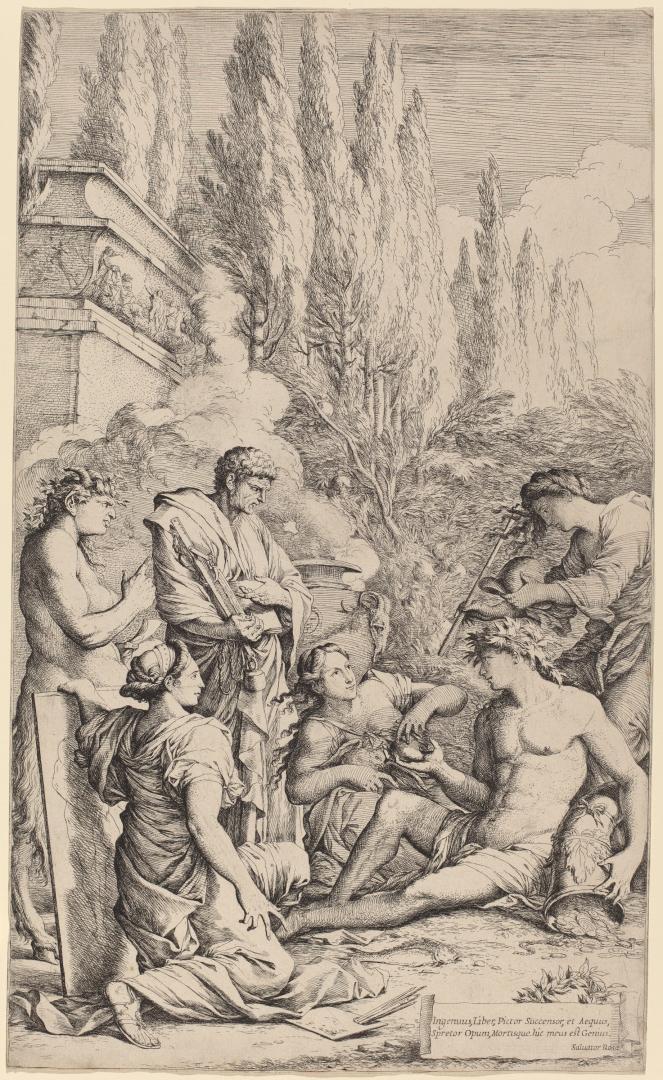
Salvator Rosa’s self-image is displayed in all its facets in an allegorical engraving with the title The Genius of Salvator Rosa, where a sign at the bottom of the composition offers a comprehensive description: ”Ingenuus, Liber, Pictor Succensor, et Aequus, / Sporator Opum, Mortisque. hic meus est Genius. / Salvator Rosa” [translated by Wallace as: “Sincere, free, fiery painter, and equable, despiser of wealth and death, this is my genius. / Salvator Rosa”].52 [fig. 6] The scene is set in a solitary graveyard, but instead of a melancholy philosopher we find Salvator Rosa himself, leaning upon a cornucopia from which money tumbles out onto the bare earth. Wearing a crown of leaves on his head, he receives or gives his “sincere, pure white heart” to a woman holding a dove – a personification of sinceritá (sincerity) – and at the same time Salvator Rosa receives the hat and sceptre of liberty from libertá (liberty).53 The other allegorical figures posing across from Salvator Rosa are la pittura (the art of painting), a Stoic philosopher holding a set of scales symbolising equilibrium, and a satyress representing satire as a literary format.
It almost goes without saying that Diogenes and Democritus, both of whom had had such great impact on the Stoic view of life, were role models for Salvator Rosa. They were natural subjects for his new ethical-heroic vein of painting, particularly as he chose to depict episodes from the lives of Diogenes and Democritus that resonated with the philosophical ethics of Stoicism. Would Salvator Rosa have seen this philosopher duo as sublime subject matter? Diogenes gives us the answer when he places the wise, i.e. philosophers, on a par with the gods, making them his friends and telling them that “what is yours is also mine”.54 Like the poet’s transcendent verse and the gods’ doings, the thinking of these two philosophers belongs to the highest strata that only the sublime can reach. With his sheer originality, borne up on the wings of his imagination, Salvator Rosa places himself right in the slipstream of philosophers, poets – and indeed of the gods themselves.
Salvator Rosa had a particular interest in philosophers as artistic subject matter, and perhaps we may read his choice of Democritus and Diogenes as a reflection of his own self-image: according to Aristotelian tradition, the artist, the poet and the philosopher all shared a sombre mind. In Longinus the sublime denotes a greatness of spirit – magnanimity, megalopsychía – and in order to create feats of sublime (oratorical) art the practitioner must possess magnanimity.55 Might one conclude that the paintings of Democritus and Diogenes reflect Salvator Rosa’s self-image as an artist, one where sublime feats rest on magnanimity, a greatness of spirit in the artist himself?
The sublime
Salvator Rosa used the Italian term sublime in his writings, expressing a hope that his own art was sublime.56 In his satire La Poesia he also speaks of sublime places and sublime subjects addressed by Pythagoras and other philosophers.57 In La Pittura the moral invention of the grand manner is presented as the greatest possible goal an artist can strive for; what Salvator Rosa also calls ethical and heroic.58 Salvator Rosa’s primary artistic ambition was undoubtedly to create something sublime; to work with sublime subject matter in the moral tenor of the grand manner.
Longinus’s treaty on the sublime, Perì Hýpsous, has traditionally been acknowledged for its major significance to art criticism and aesthetics in the eighteenth and early nineteenth centuries. In art history the concept of ‘the sublime’ has often been employed in relation to art from the Enlightenment period, Classicism and most recently the postmodern era, always with shifts in meaning that reflect changing views among philosophers such as Edmund Burke (1729–97), Immanuel Kant (1724–1804) and many subsequent thinkers.59 This is because Longinus’s writings did not become known in wider circles until the arrival of the aforementioned 1674 French translation by Despréaux-Boileau.
Recent decades have seen a renewed interest in the concept of the sublime, followed by a reassessment of the impact of Longinus’s treatise during the period prior to Despréaux-Boileau.60 Scholars have become aware that in the early modern era, in the sixteenth and up through the seventeenth centuries, a concept of the sublime existed within painting, one that tapped the rich sources of antiquity, first and foremost Longinus.61 What is more, new studies suggest that this treatise was not only known and used among scholars of the arts in Rome in the mid-seventeenth century, but that it was also used by e.g. Vasari in his Le Vite, which was first published in 1550, with an expanded edition published in 1568.62 Given that Salvator Rosa often referred to Vasari when justifying his artistic project (cf. the three stanzas from the satire Invidia at the beginning of this article), it is also relevant to include Vasari when contextualising the pendants within an ethical concept of the sublime.
Longinus
Philologists disagree on the actual identity of ‘Longinus’, which means that they also disagree on when the treaty Perì Hýpsous was written. The text has survived in a version where the title page bears the text: ”Dionysius Longinus On the Sublime”, whereas the table of contents says: ”Dionysius or Longinus”, which has been interpreted as an ‘either or’, signifying that the author is either Cassius Longinus, a Greek literary scholar from the third century AD, or Dionysius of Halicarnassus, a critic from the first century BC.63 The most widely accepted theory among philologists is that the treatise was written during the first century BC in Hellenistic Greece. Some scolars doubt the antique origin.64 In any case the reading is made challenging by a difficult style of writing and many lacunae, small and large, throughout the text. Some estimate that these missing parts account for approximately one third of the original Greek text.65
To Longinus, the objective was not merely to write yet another instructive book on the art of oratory. It is not just a didactics on rhetoric, even though its target audience consisted of practitioners of this art: orators, politicians and judges. There is one crucial difference between Longinus’s concept of the sublime and those that followed after: Longinus’s idea of the sublime has both aesthetic and ethical or moral aspects, whereas later concepts of the sublime are exclusively concerned with aesthetic theory. Longinus does not define the concept of the sublime directly, but offers a range of characteristic traits instead: the sublime has to do with a special distinction and excellence of discourse; it is the one thing that is crucial in order to win the laurels of eternal fame.66 He asks his reader whether absolutely anyone can achieve sublimity, answering his own question with a no – but everyone feels it when it is present.67 He takes his starting point in anthropology: what everyone agrees is sublime, is indeed sublime. The sublime has a universal effect, meaning that the truly sublime will have its effect on everyone and at any time.68 In other words, Longinus looks at what man feels and how he responds. If you quickly forget a given poem or the orator’s speech, or if they fall apart upon closer inspection, then those things are not sublime.
Nature – Technique
In chapter 8 of his treatise, Longinus lists five sources of the sublime.69 His focus on the orator’s or poet’s innate, inborn gifts is the one aspect of Longinus’s concept of the sublime that most clearly sets it apart from its antecedents and from later periods. The moral-ethical aspect or the artist’s possession of innate virtue as a prerequisite of achieving sublimity also emerges among the five sources he specifies: 1) the power of forming “Boldness and Grandeur in the Thoughts”; 2) “the Pathetic, or the Power of raising the Passions to a violent and even enthusiastic degree”; 3) the due formation of figures of thought and expression; 4) noble diction; and 5) the dignified and elevated composition of sentences.70 The grandeur of thoughts can be unfolded through compositional devices, i.e. by exercising good judgment in the selection and combination of details and by means of the aforementioned ‘principle of amplification’, that is a gradual accumulation and intensification.
Longinus makes an interesting distinction between the first two sources and the latter three: “and these two being genuine Constituents of the Sublime, are the Gifts of Nature, whereas the other sorts depend in some measure upon Art.”71 Categorising the first two sources of the sublime as gifts of nature represents a remarkable new departure compared to other theories of the sublime from the era.72 With this move, Longinus arranges the two categories of sources of the sublime in accordance with two familiar dichotomies in the worldview of antiquity: natura/phýsis versus ars/techne.73 Natura/phýsis belongs to nature and the realm of the natural, in this case the orator or poet’s innate gifts of nature. By contrast, ars/techne belongs to the realm of the man-made or that which man can learn.
Virtus
In his introduction Longinus discusses how one may improve one’s own nature in order to achieve spiritual greatness – a powerful mind. Mastering the technique (ars/techne) is not enough; cultivating one’s innate virtue is a prerequisite for achieving sublimity. The ethical theme of the sublime, dependent on virtue, is addressed again with renewed intensity in the final chapter of the treatise.74 Here, too, Longinus shows himself to be a Platonic thinker.75 The concept of virtue – Latin virtus, Italian virtú – denotes a wide range of meanings that go far beyond the connotations evoked by the word today. In antiquity the word held the meaning under consideration in Plato’s The Republic.76 In Salvator Rosa’s day it became a key concept in the definition of a new ideal artist figure because it has to do with a person’s magnanimity, vast intelligence, talent, and exemplary manner of thought and action.77
The dimension of virtue becomes particularly evident in Longinus’s concept of the sublime in the last chapter of his treatise, which bears the title ”The Scarcity of sublime Writers accounted for”.78 The chapter is written as a dialogue conducted with an unnamed (Stoic?) philosopher who is speaking to an assembled audience when he is interrupted by Longinus’s first-person narrator. They discuss the reasons behind the decadence of the day: is it, as the philosopher states, due to the loss of public rhetoric as a result of the democratic form of government? Or is it, as Longinus states in his countering thesis, a general ethical-moral decline that will automatically prompt a decline in Hýpsos (the sublime)? This discussion was a recurring theme in literature at the time.79
Longinus presents the position that the corrupted state of genius might have more to do with an inner state of mind than with external factors. Our internal war, the urges of mind and body, prevents the sublime from coming to fruition. Among these urges he particularly points to greed and extravagance as the vices that lead mankind into the worst kind of slavery.80 Longinus tells the philosopher and the assembly that he has given the matter a lot of thought and has arrived at the conclusion that those who worship money cannot protect their souls against the vices that are so closely associated with wealth, because extravagance will always be its companion. With these follow the other progeny of wealth: ostentation, vanity and luxury.81 These vices give birth to tyrants and makes the soul groan with pain under the weight of insolence, injustice and the most arrogant of impertinence. The corrupted state spreads like a disease, dulling virtue and the facilities of the soul, and the spirit is lost. Longinus continues his speech by stating that when man has become so preoccupied with the mortal, worthless part of himself, when he has stopped cultivating virtue and polishing what is truly noble, which is the soul, then reason and genius will fall into ruin. To him, it is the soaring flight of the soul – set free and cultivated by years of toil – that paves the way for the not only completely excellent, but also exalted and sublime performance.
Vasari’s art theory concepts
In sixteenth century Italian painting, sublimity was associated partly with grandeur and magnificence.82 This grandeur might concern the artist’s skill in terms of style, the scale of the format, the wealth of detail, the poses of the figures or a particular colour scheme – but it might also reside in breaking rules. Sublimity was associated with the experience of that which leaves you breathless with awe, but which also evokes a sense of enigma. The perception of the sublime was closely associated with a redefinition of the craft of painting within the social fabric, and during the Renaissance painting moved up the rungs of the ladder so that it was no longer regarded as a trade, but as one of the free arts, artes liberales. Painting became intellectualised, and so artists won access to the intellectual elite of society.
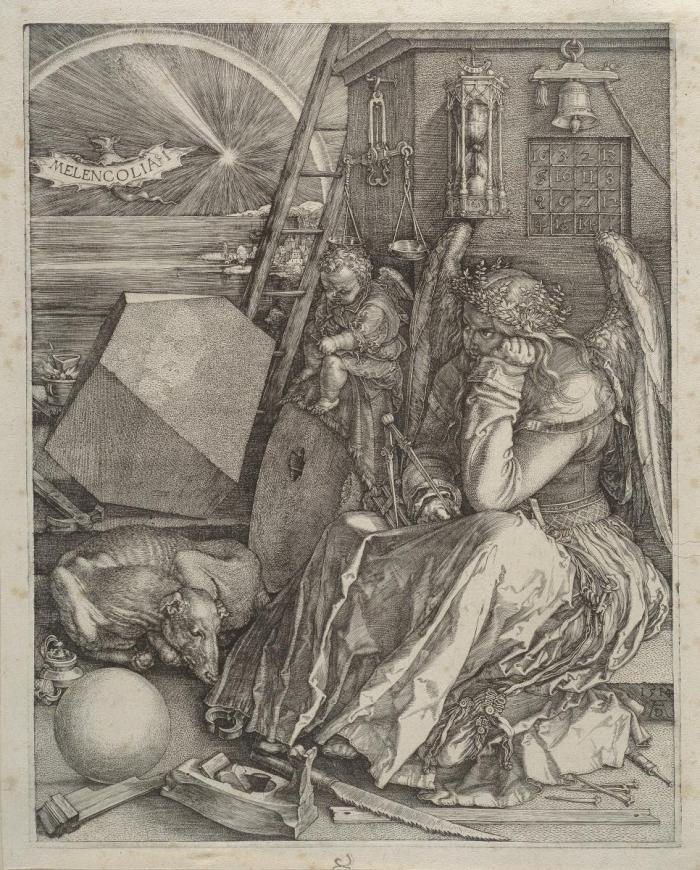
With the artist biographies in Vasari’s Le Vite we become familiar with a range of art theory concepts that helped define the new type of artist to which Salvator Rosa refers in the stanzas from the satire Invidia quoted at the beginning of this article. In Salvator Rosa’s time these concepts remained valid. One of the central concepts for his ambitions as a painter was that of nobiltá – a particular excellence that a work of art can only possess if its creator has remarkable natural (i.e. inborn) abilities.83 The concept of nobiltá is associated with aesthetic and ethical parameters such as grazia – the grace of a work of art and spiritual artistic freedom; bellezza – a perfect exterior and interior beauty of the soul, which can be expressed in the appearance of a figure; facilità – facility, ease, a gracefully effortless manner of painting. Another concept closely associated with that of nobiltá is the aforementioned concept of virtú, which had far more wide-ranging meaning in Salvator Rosa’s own day than it does today.84 Virtú was an essential concept for the new artist identity because it encompassed, as has already been touched upon, a range of traits that are innate, given by nature irrespective of ancestry, inheritance and wealth. Virtú was also, as we shall see, of key importance to the idea of genius and the definition of the sublime.
Melankoli – virtú – oscuritá
Melancholy found little favour with the ancient Stoics, for it might escalate and become paralysing, impeding the free flow of creativity.85 During the Renaissance, the Reformation theologian Philipp Melanchthon (1497–1560) also described the melancholic temperament in negative terms. The Renaissance and Baroque eras’ positive concept of creative melancholia takes its starting point in a passage in the pseudo-Aristotelian treatise Problems, claiming that all great men are melancholics.86 The ability to think creatively, to be ingenious and truly distinctive was even seen to be governed by and predicated on the melancholic temperament. The seeds of this positive view of the dark temperament may also have resided in Christianity’s appreciation of the asceticism of monastic life.
The first artist to incorporate the melancholic temperament in a positive depiction of the artist self is the German Renaissance artist Albrecht Dürer (1471–1521). In his famous engraving Melancolia I (1514, The Royal Collection of Graphic Art, the National Gallery of Denmark) he created a personification of Geometry (one of the free arts) and Melancholy in a single figure. [fig. 7] Knowing that Dürer was keen on measurements, proportions, harmonious numbers and central perspective, as is evident in his treatise Underweysung der Messung from 1525, the leap from the engraving’s allegorical composition to Dürer’s ideal self-image as a creative artist is short.87 There can be little doubt that Dürer placed himself in the slipstream of Plato and Longinus when he ascribed the deepest source of the artistic imagination to an ability that could not be learned, but only achieved through the gift of inspiration, which was the reserve of just a few.88
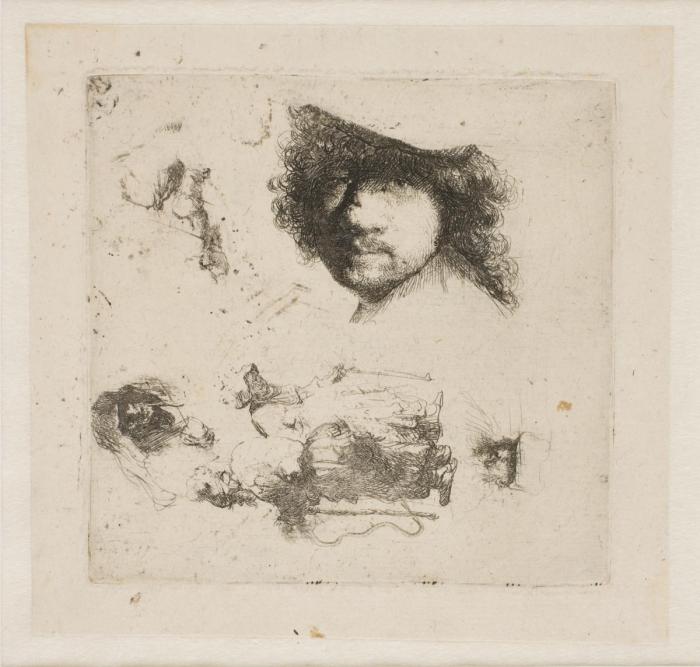
If we consider parallels closer to Salvator Rosa’s own day one might point to Rembrandt (1606–69). The Dutch master believed that the melancholic mind was also the hallmark of the creative imagination. In several painted or etched self-portraits he addressed the darkly sombre mind as an aspect of the artist identity, depicting it through metaphorical use of shadow.89 [fig. 8] In an etching featuring a range of different sketches seemingly brought together at random, the smouldering darkness conjured up by the needle includes a shadowy self-portrait amongst an array of beggars and miserable figures. It is possible that Salvator Rosa was familiar with the master prints of both Dürer and Rembrandt.
Wallace has demonstrated that in his allegorical self-portrait and the painting of Democritus, Salvator Rosa entered into a dialogue with an engraving by Giovanni Benedetto Castiglione (1609-64) from around 1645–48.90 [fig. 9] The engraving carries the inscription “Ubi Inletabilitas Ibi Virtus” (“Where there is melancholy there is virtue”). A female personification of Melancholy is shown surrounded by symbols of science. A dog, an animal that was often linked to the melancholic temperament within the cosmological worldview of the era, is tied to the monument at which the woman sits. In this work, Benedetto Castiglione associates the melancholic temperament with virtú.
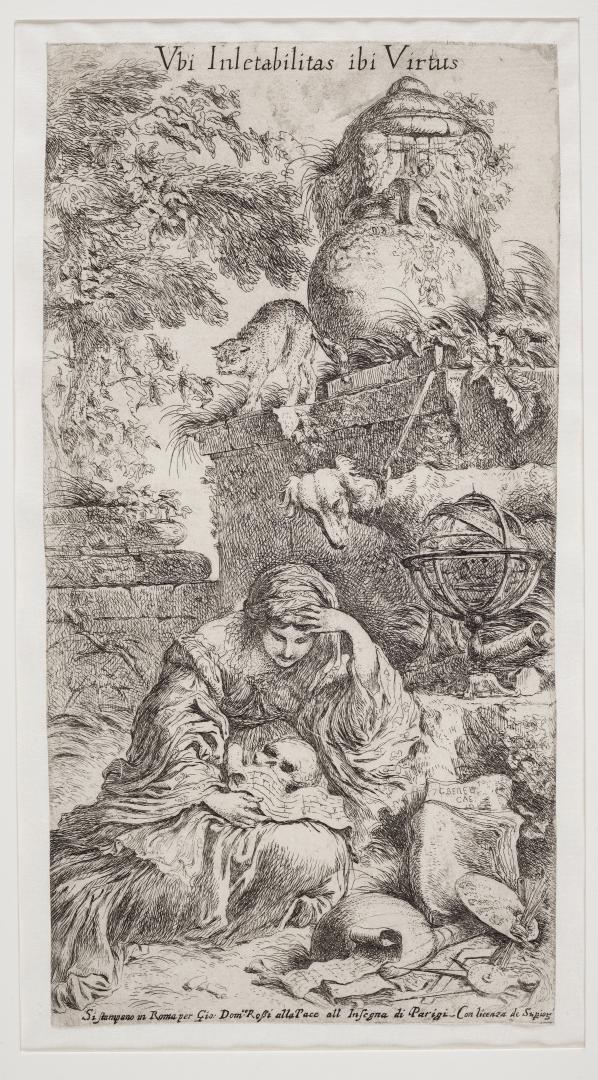
In Salvator Rosa’s day one would sometimes see a correlation between the positive view of melancholy and a particular manner of painting that was dominated by dark colours and an absence of crisp contours.91 This manner of painting was the so-called oscuritá, an extreme version of chiaroscuro. Both techniques leave the spectator with a sense that he or she has not seen everything; what is hidden in the darkness? This enigmatic quality might also extend to the subject matter – what is the painting truly about?92
Conclusion
What might Salvator Rosa have been thinking when using terms such as sublimity and sublime subject matter? The objective of this article was to elucidate this question by reviewing those parts of Longinus’s treatise that address ethics and the concept of virtú, thereby pointing to the complex connections that Salvator Rosa saw, consciously or subconsciously, between the melancholy, passive Democritus, the ascetic, active Diogenes and the Longinian sublime. Might one say that the Democritus and Diogenes paintings manifest the sublime as an artistic programme? Might one say that the paintings concern themselves with the sublime, virtú, melancholy, oscuritá and genius? Perhaps the National Gallery’s philosopher duo might also be seen as a reflection of Salvator Rosa’s own ideal self-image. Salvator Rosa was familiar with the thoughts on ethics and virtú current at the time, perhaps not directly from their original source, but certainly through the discourse of learned friends and through the general incorporation and ‘Christianisation’ of key concepts of ancient philosophy via neo-Stoicism.
As one stands before Salvator Rosa’s pendants at the National Gallery one is struck by how dark the two paintings are. Both compositions are shrouded in oscuritá, demanding a little extra from the spectator’s visual faculties and requiring them to accustom the eyes to observing all the details in the dark areas. Much of the palette is made up of variants of black mixed with other colours, combining to form a very rich, dusky colour scheme. The paintings also demand a great deal of prior knowledge on the part of the spectator: unless you are very well versed in the life stories of the two philosophers, the themes are not immediately apparent as the artist has not used well-established iconography. This contributes to the overall oscuritá in the sense of mystery – a key concept within the terminology of the sublime presented in Vasari’s artist biographies, and one that was closely related to the melancholic temperament, the hallmark of artists and philosophers alike. This ‘learned’ approach not only identifies Salvator Rosa as a painter-philosopher; it also requires special insight on the part of the spectator.
The composition places figures, tree trunks and darkness in a harmonious interplay of details and totality, thereby drawing on the rhetorical device of amplificatio, amplification, which according to Longinus is one of the paths orators can take as they pursue sublimity. Another element crucial to our understanding of Salvator Rosa’s philosopher duo is the mutually complementary concepts of virtú, melancholy, oscuritá, genius and sublimity. The philosopher motif in itself represents the melancholic temperament, especially Democritus with his smiling yet sad expression. He can be said to be doubly afflicted, for the object of his own studies is the anatomy of that very temperament.
This study of the National Gallery’s philosopher duo has given rise to the hypothesis that Salvator Rosa envisioned his juxtaposition of the meditative Democritus and the ascetic Diogenes because he regarded the two Greek philosophers as images of his own Stoic artist persona; a self-image where concepts such as nobiltá and virtú were omnipresent in his endeavours to create sublime art. The grandeur of thought unfolds itself through form and content. Perhaps Salvator Rosa was aware of Longinus’s treatise, of his thoughts on the sublime and on how virtú was a cornerstone of that concept. Salvator Rosa wanted to create sublime art when he secluded himself at Monte Rufoli, an artist-philosopher eager to do his very best.
So where can one see Salvator Rosa’s sublimity in the pendants? In the construction of the ethical-heroic philosopher motif and in the choice of juxtaposing Democritus and Diogenes; in a special principle of composition that adopts the rhetorical device of amplificatio; in the interpretation of oscuritá, which refers partly to a severely restricted palette of dark colours, to an enigmatic iconography and to a dark temperament characteristic of the artist and philosopher as types. ▢
Post scriptum: I wish to acknowledge the Novo Nordisk Foundation for funding during the preparation of this article
Translation by René Lauritsen
The top image is a detail of Salvator Rosa: The Genius of Salvator Rosa. National Gallery of Art, Washington, see fig. 6.

